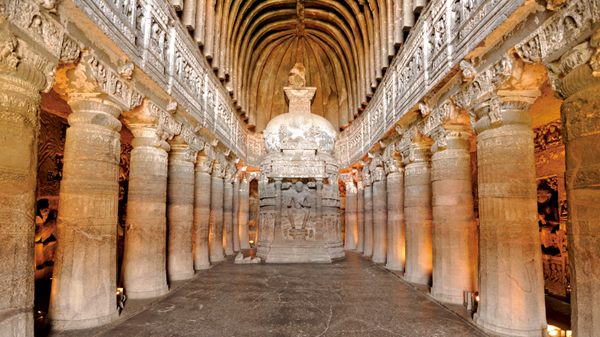
Ajanta and Ellora: India’s iconic religious caves
A treasure trove of historical monuments, the Ajanta and Ellora Caves number among UNESCO’s World Heritage Sites and are two of the Seven Wonders of India. A monument to human ingenuity and perseverance, they took centuries to finish.
Settled some 9,000 years ago, India is not only one of the world’s oldest civilisations, it also boasts one of the richest cultural traditions. Nowhere is this more evident than in its religious history. After all, the nation was the birthplace for four now-iconic faiths: Hinduism, Buddhism, Sikhism and Jainism. Although worshippers spread across the globe, there is one region in particular that remains an enduring hallmark of their inception.

The Ajanta and Ellora Caves are celebrated as one of the best examples of rock cave architecture in India, the Ajanta and Ellora Caves – lying some 95km apart from each other – are situated in the state of Maharashtra near the city of Aurangabad and have been worshipped for over a millennium.

The Ajanta Caves boast roughly 300 rock-cut Buddhist cave monuments across 29 caves, all of which were constructed between the 2nd century BC and 6th century AD. Using only chisels and hammers, Buddhist monks carved directly into the cliff face of the Sahyadri Hills. These caves include paintings, murals, sculptures that illustrate the previous life of Buddha. This form of literature is known as the Jataka Tales, and is primarily native to India.
The Ajanta Caves, comprising solely Buddhist caves, stood unknown until it was accidentally rediscovered in 1819 by a young British cavalry officer, John Smith. Spotting the mouth of a cave above the Waghora (Tiger) River, he entered and discovered the statue of a Bodhisattva, a figure representing one of the past lives of the Buddha before he achieved Nirvana. On it, Smith carved his name. Since then, thousands of tourists have followed suit.

While the Ajanta Caves have some of India’s most sophisticated ancient paintings, the Ellora Caves are renowned for their extraordinary architecture, having been crafted entirely by hand. It occupies a flat rocky region on the Western Ghats, where the geology of the landscape was shaped by volcanic activity, creating a multi0layed basalt formation known as the Deccan Traps. The resulting steep vertical surface layered with rock formations enabling the architects of the time to carve the stone for more detailed sculpting.

The area comprises 34 caves in total featuring a mixture of 12 Buddhist (caves 1–12), 17 Hindu (caves 13–29) and 5 Jain (caves 30–34) caves, as well as monasteries dedicated to each religion. The Buddhist caves were built during the Chalukya dynasty (500-1100 AD), the Hindu caves by the Rashtrakuta dynasty (500-900 AD) and the Jaina caves by the Yadava dynasty (860-1317 AD). Though the earliest caves may have been built during the dynasties of the Traikutakas (388 and 456 AD) and the Vakataka (250-270 AD), the latter also being known for sponsoring the Ajanta caves.

A key draw here is undoubtedly the incredible Kailasa Temple (also known as the Kailasha Temple), dedicated to Lord Shiva and his sacred abode at Mount Kailasha. Its immense size covers twice the area of the Parthenon in Athens and is one and a half times as tall. So great is its acreage that its true size can only be taken in when viewed at a distance.

Lying between the two ancient religious cave complex lies yet another stunning example of Indian architecture, albeit one from a more recent era – the Bibi Ka Maqbara. Loosely translating to “Tomb of the Lady”, it was commissioned by Mughal emperor Aurangzeb in 1660 as a tribute to his chief wife, Dilras Banu Begum. Dubbed by some as a miniature Taj Mahal, the similiarities are undeniable, and perhaps understandable when you consider the fact that the Taj Mahal was similarly commissioned by Aurangzeb 30 years previously upon the death of his mother.
The central marble-dominant mausoleum, featuring four towering turrets, is further ringed with a tranquil open garden, standing in stark contrast to Ajanta and Ellora’s dimly-lit caverns – a fact that visitors are sure to enjoy.

Although there are a handful of accomodations on site near all three locations, many offer only basic amenities. For a more luxurious option, a handful of high-end establishments can be found in Aurangabad city. While this does mean several hours of transit time to and from the Ajanta and Ellora Caves, hotels such as, Vivanta Aurangabad, a five-star outpost of the venerable Indian luxury brand, Taj Hotels & Resorts will offer well-heeled travellers with a more luxurious experience.







